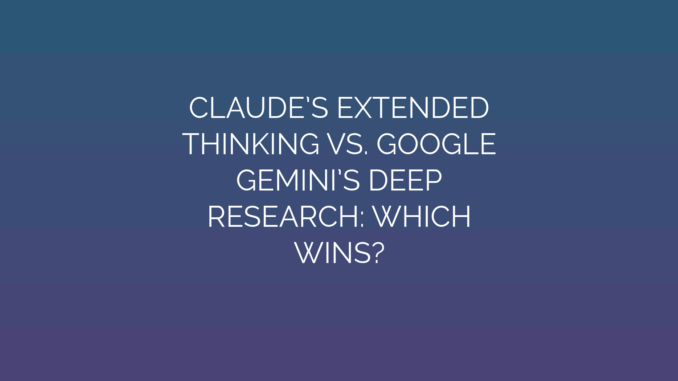
Claude’s Extended Thinking vs. Google Gemini’s Deep Research: Which Wins?
The rapid evolution of artificial intelligence has introduced powerful tools for tackling complex tasks, with Anthropic’s Claude and Google’s Gemini emerging as frontrunners. Claude leverages extended thinking techniques for nuanced reasoning, while Gemini harnesses deep research capabilities and integration with Google’s ecosystem. This article dissects their strengths, use cases, and limitations to determine which AI might best serve your needs.
Understanding Claude’s Extended Thinking
Claude, developed by Anthropic, emphasizes logical reasoning and longcontext processing. Its architecture enables “chainofthought” reasoning, breaking down intricate problems into sequential steps for accurate outcomes. Key features include:
- Extended Context Windows: Supports up to 200,000 tokens, allowing analysis of lengthy documents like legal contracts or research papers.
- Constitutional AI Principles: Prioritizes harmlessness and ethical responses by aligning outputs with predefined human values.
- Iterative Reasoning: Excels at multi-step tasks—such as solving math problems or generating structured reports—through self-correction loops.
Claude’s design minimizes hallucinations (fabricated information) and excels in creative ideation, making it ideal for drafting, summarizing, and strategic planning. However, its lack of realtime web access limits its ability to pull fresh data beyond its training cutoff.
Exploring Google Gemini’s Deep Research
Google Gemini capitalizes on sophisticated grounding in Google’s search infrastructure and proprietary datasets. Unlike Claude, it emphasizes realtime information retrieval and multimodal processing:
- Deep Search Integration: Accesses current data via Google Search, Scholar, and Workspace apps, providing citations and up-to-date facts.
- Multimodal Expertise: Processes text, images, audio, and code simultaneously—useful for analyzing graphs or translating technical diagrams.
- Scalable Architecture: Offers tiered models (Nano, Pro, Ultra) optimized for devices ranging from smartphones to data centers.
Gemini suits researchintensive tasks requiring citations, trend analysis, or collaboration via Gmail or Docs. It occasionally overrelies on search results, potentially inheriting biases or inaccuracies from lowquality sources.
Comparing Strengths and Weaknesses
Accuracy and Depth:
- Claude’s extended thinking ensures meticulous logic in problem-solving but lacks real-time data.
- Gemini’s deep research excels in factual accuracy for current events but can propagate errors from aggregated web sources.
Speed and Usability:
- Gemini processes multimodal inputs faster, aided by Google’s TPU hardware.
- Claude prioritizes conversational depth, responding thoughtfully to ethical dilemmas or abstract queries.
Limitations:
- Claude struggles with dynamic knowledge (e.g., stock prices or news).
- Gemini’s output quality varies across modalities; its coding skills lag behind Claude’s precision.
Practical Applications
Best for Claude:
- Drafting policy documents or literary content requiring narrative coherence.
- Brainstorming sessions requiring unbiased, step-by-step reasoning.
- Analyzing historical data or fixed datasets (e.g., annual reports).
Best for Gemini:
- Academic research involving citations from recent studies.
- Competitor analysis using live market trends or social media.
- Troubleshooting technical issues via image/voice inputs (e.g., identifying hardware from a photo).
Which Wins? Context Is Key
Neither model universally “wins”—the choice hinges on task requirements:
- Choose Claude for projects demanding extended thinking: creative writing, ethical decision-making, or processing large static documents. Its strenght is structured reasoning without real-time dependencies.
- Choose Gemini for scenarios requiring deep research skills: data-driven reports, real-time fact-checking, or cross-referencing visual and textual data. Its advantage is information breadth via Google’s ecosystem.
In hybrid workflows—using Claude to outline a research paper and Gemini to source citations—both can complement each other.
Conclusion
Claude and Gemini represent divergent philosophies: Claude prioritizes depth of thought, while Gemini emphasizes breadth of information. For businesses, Claude’s safetyfocused design minimizes risks in sensitive communications, whereas Gemini’s integration with Google tools accelerates dataheavy tasks. As both models evolve, users will increasingly blend their capabilities—leveraging extended reasoning for innovation and deep research for execution. The ultimate winner is determined not by raw capability but by alignment with your specific objectives in an AIaugmented workflow.
Leave a Reply